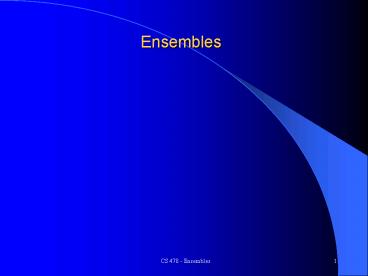Ensembles PowerPoint PPT Presentation
1 / 10
Title: Ensembles
1
Ensembles
2
A Holy Grail of Machine Learning
Outputs
Automated Learner
Just a Data Set or just an explanation of the
problem
Hypothesis
Input Features
3
Ensembles
- Multiple diverse models (Inductive Biases) are
trained on the same problem and then their
outputs are combined - The specific overfit of each learning model is
averaged out - If models are diverse (uncorrelated errors) then
even if the individual models are weak
generalizers, the ensemble can be very accurate - Many different Ensemble approaches
- Stacking, Gating/Mixture of Experts, Bagging,
Boosting, Wagging, Mimicking, Combinations
Combining Technique
M1
Mn
M3
M2
4
Bias vs. Variance
- Multiple trained models can average out the
variance - Leaving just the Bias
- Combining weak learners
- Assume n induced models which are independent of
each other and each has accuracy of 60 on a two
class problem. If all n give the same class
output then you can be confident it is correct
with probability 1-(1-.6)n. For n10, confidence
would be 99.4. - Normally not independent. If all n were the same
model, then no advantage could be gained. - Also, unlikely that all n would give the same
output, but if a large majority did, then still
get an overall accuracy better than the base
accuracy of the models - Change to if majority
5
Bagging
- Bootstrap aggregating (Bagging)
- Great way to improve overall accuracy by
decreasing variance - Often used with the same learning algorithm and
thus best for those which tend to give more
diverse hypotheses based on initial random
conditions - Induce m learners starting with same initial
parameters with each training set chosen
uniformly at random with replacement from the
original data set - All m hypotheses have an equal vote for
classifying novel instances - Consistent significant empirical improvement
- Does not overfit (whereas boosting may), but may
be more conservative overall on accuracy
improvements - Could use other schemes to improve the diversity
between learners - Different initial parameters, sampling
approaches, etc. - Different learning algorithms
- The more diversity the better - (yet most often
used with the same learning algorithm and just
different training sets)
6
Boosting
- Boosting by resampling - Each TS chosen randomly
with distribution Dt with replacement from the
original data set. D1 has all instance equally
likely to be chosen. Typically each TS is the
same size as the original data set. - Induce first model. Change Dt1 so that
instances which are mis-classified by the current
model have a higher probability of being chosen
for future training sets. - Keep training new models until stopping criteria
met - M models induced
- Overall Accuracy levels out or most recent model
has accuracy less than .5 on its TS - Etc.
- All models vote but each models vote is scaled
by its accuracy on the training set it was
trained on - Boosting is more aggressive than bagging on
accuracy but in some cases can overfit and do
worse can theoretically converge to training
set - On average better than bagging, but worse for
some tasks - In some cases worse than the non-ensemble case
- Many variations
7
Ensemble Creation Approaches
- A good goal is to get less correlated errors
between models - Injecting randomness initial weights, different
learning parameters, etc. - Different Training sets Bagging, Boosting,
different features, etc. - Forcing differences different objective
functions, auxiliary tasks - Different machine learning models
- One aspect of COD (Classifier Output Distance)
research - which algorithms are most different
and thus most appropriate to ensemble
8
Ensemble Combining Approaches
- Unweighted Voting (e.g. Bagging)
- Weighted voting based on accuracy (e.g.
Boosting), learned (single layer), training set,
etc. - Stacking - Learn the combination function
- Higher order possibilities
- Which algorithm should be used for the stacker
- Stacking the stack, etc.
- Gating function/Mixture of Experts The gating
function uses the input features to decide which
combination (weights) of expert voting to use
9
Ensemble Summary
- Efficiency
- Wagging (Weight Averaging) - Multi-layer?
- Mimicking - Oracle Learning
- Other Models - Instance weighted voting, PDDAGS
(Parallel Decision DAGs), etc. - Almost always gain accuracy improvements by
decreasing variance
10
Ensemble Assignment
- http//axon.cs.byu.edu/martinez/classes/478/Assig
nments.html

